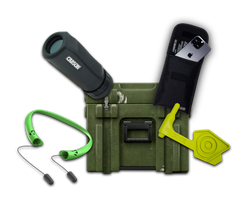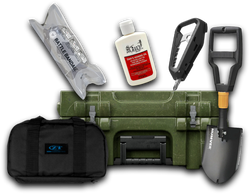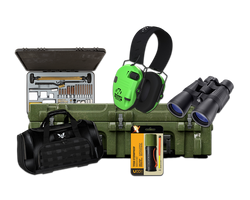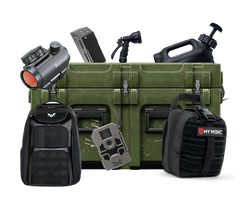What is the Best Knife for Self Defense?
Table of Contents
- Introduction
- Understanding Self-Defense Knives
- Key Features to Look for in a Self-Defense Knife
- Types of Knives for Self-Defense
- Training and Responsible Usage
- Conclusion
- FAQ
Introduction
When it comes to self-defense, preparation is key. While many people think of firearms or other forms of weaponry for protection, a knife can be an incredibly effective tool in a self-defense scenario. The importance of understanding which knife is best suited for self-defense cannot be overstated. With the right knife, you can ensure that you're not only prepared for unexpected encounters but also able to respond effectively and confidently.
Knives designed for self-defense are crafted with specific features that make them suitable for close-quarter combat. This blog will delve into the characteristics that define the best self-defense knives, explore various types of knives available in the market, and offer insights into what makes each unique. Whether you're a seasoned tactician or someone just looking to enhance your personal security, this guide will provide you with valuable information to make an informed decision.
By the end of this post, you'll not only understand what to look for when selecting a self-defense knife but also discover specific models that exemplify these qualities. Additionally, we'll discuss the importance of training and responsible usage, ensuring that you are fully equipped to handle a knife in a self-defense situation.
So, whether you're considering your first knife or looking to upgrade your current tool, let's explore what makes a knife the best choice for self-defense.
Understanding Self-Defense Knives
What is a Self-Defense Knife?
Self-defense knives are designed specifically for defensive purposes, prioritizing features that enhance their effectiveness in close-quarters situations. Unlike general-purpose knives, self-defense knives often have characteristics that make them more suitable for offensive use. These knives can vary widely in design, but they generally share a few common features:
- Blade Design: Self-defense knives typically have blades designed for piercing and slashing rather than for utility tasks. Common blade shapes include tanto, hawkbill, and dagger styles.
- Ergonomics: A good self-defense knife should fit comfortably in the hand, allowing for a secure grip during use. Many models are designed for reverse grip usage, which can enhance control during a confrontation.
- Deployment Mechanism: Speed is crucial in a self-defense situation. Many self-defense knives feature quick-deployment mechanisms, such as thumb studs, flippers, or automatic openers, allowing for rapid access when needed.
Why Carry a Self-Defense Knife?
The reasons to carry a self-defense knife are varied, but they primarily revolve around personal safety and preparedness. Here are a few compelling reasons:
- Immediate Access: Knives can be drawn quickly and are often easier to carry than firearms, making them an effective choice for self-defense.
- Versatility: Beyond self-defense, knives can serve practical purposes in everyday life, from opening packages to emergency situations requiring cutting tools.
- Concealability: Many self-defense knives are designed to be compact and easily concealable, allowing for discreet carry.
Key Features to Look for in a Self-Defense Knife
Understanding the essential features of a self-defense knife is crucial when making a purchase. Here are the fundamental aspects to consider:
1. Blade Type
Different blade types serve different purposes. When selecting a self-defense knife, consider the following:
- Tanto Blade: Known for its strength and piercing ability, the tanto blade is excellent for thrusting attacks.
- Hawkbill Blade: This design is ideal for slashing motions, making it effective in close-quarters combat.
- Dagger: With a double-edged design, daggers offer excellent piercing capabilities and are often designed for thrusting attacks.
2. Blade Length
The length of the blade is another critical factor. Generally, a blade length of 3 to 5 inches is considered optimal for self-defense, balancing concealability with effectiveness. Longer blades may provide more reach but can be cumbersome to carry and deploy.
3. Handle Design
A well-designed handle is essential for maintaining control during a confrontation. Look for:
- Material: Handles made from G-10, Micarta, or aluminum provide a good grip and durability.
- Texturing: A textured handle enhances grip, especially under duress.
- Shape: The handle should be ergonomically shaped to fit comfortably in your hand, allowing for both regular and reverse grips.
4. Deployment Mechanism
The speed at which you can access your knife is vital. Consider knives with:
- Thumb Studs or Flippers: These allow for quick one-handed deployment.
- Automatic Openers: These knives deploy with the push of a button, offering the fastest access.
5. Locking Mechanism
For folding knives, a robust locking mechanism is crucial. Options include:
- Frame Lock: Provides a secure lockup by using the handle's frame to keep the blade in place.
- Liner Lock: A secondary liner within the handle keeps the blade secure during use.
Types of Knives for Self-Defense
When it comes to self-defense knives, there are two main categories: fixed blades and folding knives. Each has its pros and cons.
Fixed Blade Knives
Pros:
- Strength: Fixed blades are generally stronger and more durable than folding knives.
- Ease of Deployment: They can be drawn quickly from their sheath, making them ideal for immediate use.
Cons:
- Concealability: Fixed blades can be more challenging to conceal and carry comfortably.
- Legal Restrictions: Some jurisdictions have strict laws governing the carry of fixed blades.
Recommended Models:
- Ka-Bar TDI Law Enforcement Knife: Compact and designed specifically for self-defense, this knife features a 2.31-inch blade and an ergonomic handle.
- Cold Steel SRK: Known for its toughness, the SRK features a 6-inch blade and is versatile enough for both utility tasks and self-defense.
Folding Knives
Pros:
- Portability: Folding knives are compact and easy to carry in pockets or bags.
- Concealability: They can be easily concealed, making them an excellent choice for everyday carry.
Cons:
- Deployment Speed: Some folding knives require more time to deploy than fixed blades, which can be a disadvantage in urgent situations.
Recommended Models:
- Spyderco Para Military 2: Known for its balance of utility and combat readiness, the PM2 features a 3.45-inch blade and a robust compression lock.
- Benchmade Griptilian: A versatile EDC knife with a 3.45-inch blade, the Griptilian is known for its excellent ergonomics and quick deployment.
Training and Responsible Usage
While owning a self-defense knife is a step towards preparedness, it's essential to understand that effective usage requires training. Here are a few points to consider:
Importance of Training
- Skill Development: Understanding how to use your knife effectively can make a significant difference in a self-defense scenario. Basic training in knife fighting techniques can enhance your confidence and effectiveness.
- Legal Knowledge: Familiarize yourself with local laws regarding knife carry and use. This knowledge is crucial in ensuring that you're not inadvertently violating any regulations.
Responsible Usage
- Situational Awareness: Always be aware of your surroundings and potential threats. A knife should be a last resort in self-defense situations.
- De-escalation Techniques: Whenever possible, try to de-escalate a situation before resorting to the use of a weapon.
Conclusion
Selecting the best knife for self-defense is a crucial decision that requires careful consideration of various factors, including blade type, length, handle design, and deployment mechanisms. Both fixed and folding knives offer unique advantages, and understanding your specific needs and preferences is vital.
As you become part of the tactical and survival community, remember that knowledge and preparedness are your strongest allies. Crate Club offers a range of curated tactical gear, including knives that suit self-defense purposes, available through their subscription service and shop.
Explore Crate Club's offerings through the following links:
Equipped with the right knife and the knowledge to use it effectively, you can enhance your personal safety and confidence. Always prioritize training and responsible usage, and stay vigilant in your everyday surroundings. The best knife for self-defense is not just about the blade; it's about being prepared for whatever life throws your way.
FAQ
What is the best blade length for self-defense?
A blade length of 3 to 5 inches is generally considered ideal for self-defense. This range provides a balance between concealability and effectiveness, allowing for quick deployment and a solid reach.
Are fixed blades better than folding knives for self-defense?
Fixed blades typically offer greater strength and ease of deployment, making them very effective for self-defense. However, folding knives are more portable and easier to conceal. The best choice depends on your specific needs and local laws.
Do I need training to carry a self-defense knife?
While it's not legally required to have training, it is highly recommended to ensure you can effectively and safely use your knife in a self-defense situation. Training also helps you understand legal implications and responsible usage.
Can I carry a self-defense knife in public?
Carrying a self-defense knife in public is subject to local laws and regulations. Always check your local laws to ensure compliance regarding carry methods and blade lengths.
What features should I look for in a self-defense knife?
Look for a knife with a strong and effective blade design (like tanto or hawkbill), a comfortable and secure handle, a reliable deployment mechanism, and a solid locking mechanism for folding knives.
Share this article



